How can planners and designers look beyond the surface when addressing the impacts of climate change on water systems?
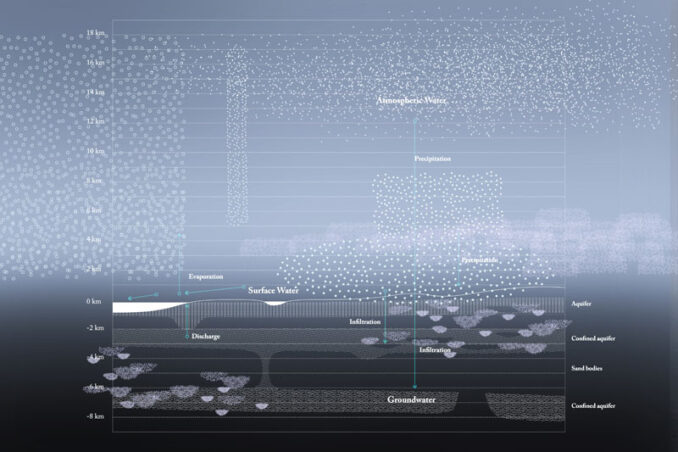
As cities around the world develop resiliency plans to prepare for the impacts of climate change, landscape architects, urban planners, and engineers play a critical role. They not only develop actionable solutions to specific challenges but also define the challenges themselves. Sitting at the confluence of diverse professions, landscape architects and planners are in a unique position to guide broad teams of consultants in the production of holistic plans to address these challenges. This process has the power to guide the conversation around climate adaptive design.
While built projects in landscape architecture deal with complex water systems (often out of necessity), coastal resiliency projects in the planning stage often fall short, focusing primarily on the impacts of sea-level rise on flooding. How can planners and designers look beyond surface water when addressing the impacts of climate change on water systems? Can the entire water system be engaged in our adaptation strategies? Let’s explore the physical and cultural significance of groundwater and atmospheric water in planning in the face of climate change.
Groundwater, the water beneath our feet, is in flux. Due to climate change, groundwater is scarce in some places but abundant in others, necessitating significant landscape interventions.
Despite an understanding that groundwater is impacted by climate change, and that the vulnerability of coastal cities is directly tied to groundwater, groundwater is rarely mentioned in resiliency planning. In the Miami Forever Climate Ready report, groundwater is noted twice, and once in New York City’s Stormwater Resiliency Plan report. But groundwater is critically linked to a changing climate—a reality we are seeing play out daily in urban areas globally.
Cities worldwide are grappling with a spectrum of groundwater challenges. There are cities shrinking: Miami, settled above the Biscayne Aquifer, faces sinking due to saltwater intrusion driven by rising sea levels; In Bangkok, a city nestled on a river delta, excessive groundwater extraction and soil composition contribute to its gradual subsidence. There are cities with saltwater intrusion: The Netherlands, known for its innovative water management, is redefining paradigms in response to climate extremes that challenge its historical engineering solutions. There are cities facing groundwater depletion: Berlin‘s reliance on groundwater sustains its urban expanse, but the surrounding Brandenburg Region witnesses water level declines, leading to fluctuations and impacting natural landscapes; Mexico City contends with vanishing groundwater storage and heightened flooding risks exacerbated by climate change.
These are only a sample of the significant impact shifting groundwater dynamics have had on many global cities. These cities have typically had to react to these impacts after the fact—how can planners and designers better anticipate these dynamics?
Sasaki is currently engaging with groundwater in projects globally, with three significant projects near our Boston, MA office. At Boston City Hall Plaza, over 45,000 SF of permeable pavement and planting areas were created. 60% of the plaza’s surface is now either porous plant beds or made of permeable materials. In one storm event at the renovated Boston City Hall Plaza, over 180,000 gallons of water were infiltrated, and 10,000 gallons were collected by a harvesting tank for recirculation as irrigation.

Reintroducing this amount of groundwater infiltration in the city has created complexities that had to be considered and monitored in design and construction. A series of groundwater monitoring wells were installed and monitored during construction. These wells, paired with sensors monitoring the movement of below-grade infrastructures ensured that the new groundwater dynamics were not negatively impacting existing infrastructure.
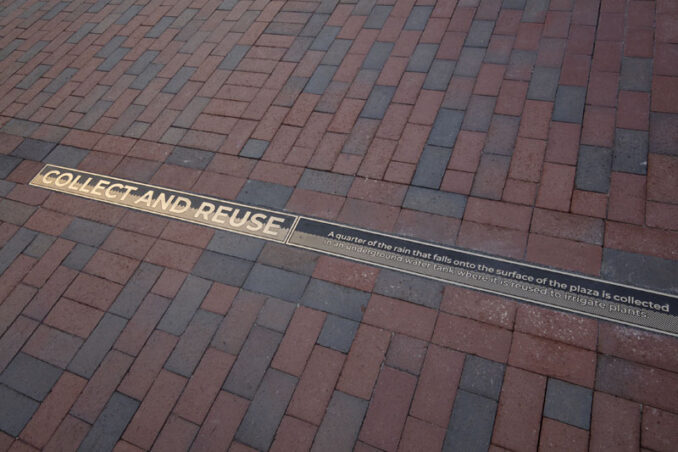
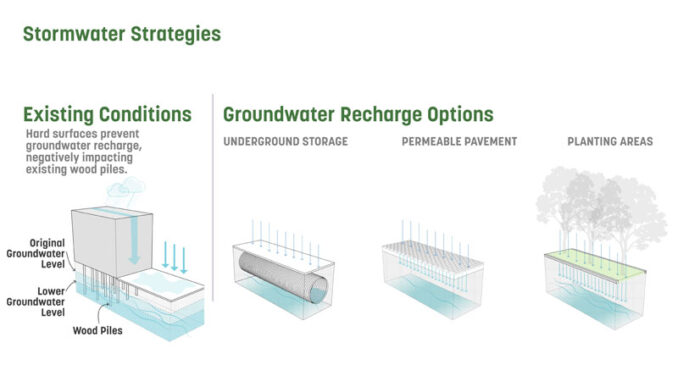
Atmospheric Water, the water above our heads, is intertwined with global climatic risks. How can planners, designers, and engineers engage with atmospheric water—an open territorial hydrology system—to mitigate temperature, cloud-cover, and precipitation extremes, fostering regional collaboration in resiliency projects?
Atmospheric water, often overshadowed by ground hydrology, deserves greater attention as a crucial dimension of resilient water strategy interventions. Within the context of more frequent extreme storm events, droughts, and unusual humidity, atmospheric water is intertwined with regional water resource security, cities’ risk capacity, and people’s comfort in public spaces. Thus, it is essential to view atmospheric water not only as a precipitation indicator and resource but also to recognize its experiential and aesthetic significance.
Additionally, atmospheric water impacts climate trends. In line with the article “A World without Clouds” in Quanta Magazine, low-lying clouds like stratocumulus clouds play a role in cooling the climate system. Such clouds reflect a substantial portion of incoming solar radiation back into space, consequently diminishing solar energy absorbed by the Earth’s surface. However, the mounting concentration of greenhouse gasses threatens the quantity and density of these clouds, raising concerns as trapped heat decelerates the cloud condensation process. The fate of atmospheric water is intrinsically linked to global temperature changes.
Managing these changes in atmospheric moisture demands intricate and adaptable microclimate design. Sasaki collaborated with the City of Boston to create a visionary set of urban heat mitigation strategies. The resulting city-wide heat plan seamlessly integrates shade structures, misting veils, and engaging installations into the city’s infrastructure. Boston is undergoing atmospheric changes, rendering it increasingly susceptible to severe weather events—particularly extreme heat, which is felt most in neighborhoods that have experienced systemic inequities like redlining. The plan focuses on heat resilience investments driven by community priorities to provide relief during heat waves and create cooler neighborhoods over time.
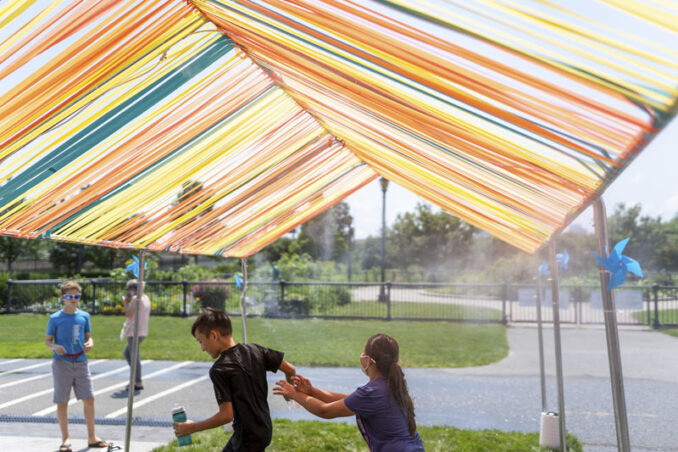
Outside of a design context, many cultures have found meaningful ways to connect with atmospheric water. Sasaki landscape designer Liwei Shen’s graduate thesis, “The Echoes of Sky River,” explores a link between indigenous divinity and precipitation. Among the Yugur nomadic ethnic group in Northwestern China, the Yugur partake in a ceremonial smoke ritual that expresses gratitude to the sky and augments atmospheric condensation nuclei, creating a higher chance of rainfall. This reflects an indigenous cosmology where the sky responds to human interaction, fostering ecological benefits like pasture restoration through heavy rain after grazing. The various interpretations of the causality create an aesthetic ambiguity and provide an opportunity to promote reciprocal and innovative landscapes, respecting living traditions, natural cycles, and ecological restorations.
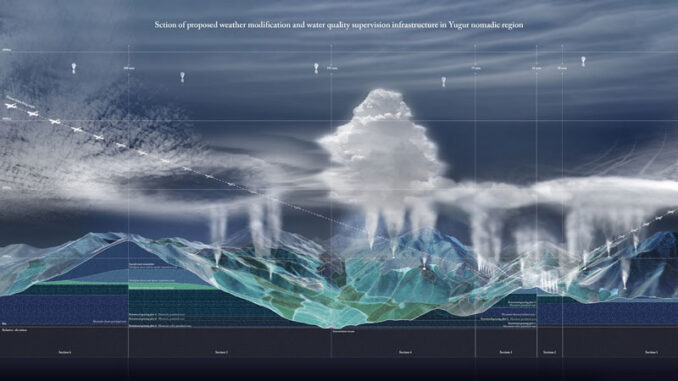
Climate change typically starts as a local issue binding people’s lifestyles and cosmologies, and eventually emerges as a paramount global concern necessitating action from all sides. This phenomenon can be seen in the global atmospheric water circulation, engaging everyone within the dome of the atmosphere. Shen’s thesis project “The Echoes of Sky River” emphasizes that people have an extensive history of manipulating precipitation. Throughout millennia, methods of connecting with and interpreting the sky have been utilized, while contemporary cloud seeding technology is now employed to combat drought. The catalysts, dispersed during cloud seeding, such as silver iodides, at times linger in the atmosphere, are propelled by prevailing winds or are deposited on land through rain, which highlights the emergence of cross-regional environmental toxins and concerns. Atmospheric water has long constituted an artificial territory, necessitating urgent regional and collaborative strategies.
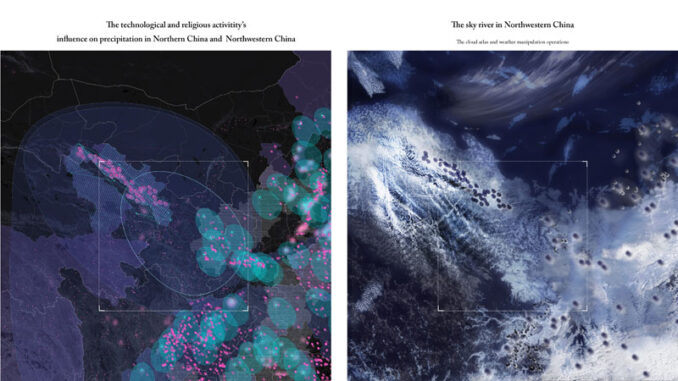
Water beyond the surface – groundwater and atmospheric water, binds climate change’s local roots to global urgency.
Planners, designers, and engineers must look beyond the surface when addressing the impacts of climate change on water systems.
As we set in motion the projects envisioned within the resiliency plans of the past decade and chart a course for the future, it is imperative to embrace a comprehensive outlook on water systems. Let us embark on a journey that unearths hidden complexities, elevates our aspirations, and fosters collaboration among our teams and communities. By tending to all facets of the challenges before us—both conspicuous and concealed—we can forge a path towards a more resilient and sustainable future.
Water Beyond the Surface by Garrett Craig-Lucas and Liwei Shen
